Overcoming E-commerce Challenges: Strategies for Conversion Rate Optimization
E-commerce has revolutionized the way we conduct business. With online shopping becoming increasingly prevalent, it is essential for e-commerce businesses to maximize their conversion rates to drive revenue and sustain growth. However, the intensifying competition poses significant challenges for businesses striving to achieve their objectives. In this article, we explore comprehensive strategies for Conversion Rate Optimization (CRO) that can help e-commerce businesses overcome common hurdles and enhance their sales performance.
Understanding the Importance of Conversion Rate Optimization in E-commerce
Conversion Rate Optimization (CRO) involves optimizing your website to increase the percentage of visitors who complete desired actions, such as making a purchase. In the context of e-commerce, the conversion rate is a critical metric that directly influences revenue and profitability. Enhancing the conversion rate is paramount for the success of e-commerce businesses because:
- Increased Sales: Higher conversion rates lead to more sales without necessarily increasing traffic.
- Improved Customer Satisfaction: Optimized websites offer better user experiences, leading to greater customer satisfaction.
- Enhanced Brand Loyalty: Satisfied customers are more likely to return and recommend your brand to others.
According to a study by Invesp, the average e-commerce conversion rate is around 2.86%, but top performers achieve rates above 5%. Understanding your target audience and their behavior on your website is essential. By analyzing user data, such as click-through rates and bounce rates, you can identify areas that require improvement, including:
- Optimizing website layout
- Enhancing user experience (UX)
- Streamlining the checkout process
Additionally, A/B testing enables you to test different website variations to determine which version yields better conversion rates. Continuous monitoring and optimization are vital to staying ahead of the competition and achieving long-term success.
Common Challenges Faced by E-commerce Businesses and How to Overcome Them
Identifying Barriers to Conversion
E-commerce businesses often grapple with understanding why visitors fail to convert. High bounce rates, cart abandonment, and low engagement levels are indicators of underlying issues. To tackle these challenges, businesses should:
- Thoroughly analyze website data
- Identify specific barriers preventing conversions
- Develop and implement effective strategies to address these barriers
Managing Inventory and Logistics
As e-commerce businesses grow, managing inventory and logistics becomes increasingly complex. Challenges such as stockouts, delayed shipments, and inventory inaccuracies can lead to dissatisfied customers. To mitigate these issues, businesses can:
- Invest in robust inventory management software
- Partner with reliable logistics providers
- Implement real-time inventory tracking systems
By maintaining accurate inventory levels and ensuring timely delivery, businesses can enhance customer satisfaction and loyalty.
Key Strategies for Optimizing Conversion Rates
Crafting a Compelling Value Proposition
Your value proposition differentiates your business from competitors. A strong value proposition should be:
- Clear and concise
- Convincing and compelling
To develop an effective value proposition, you should:
- Identify your target audience
- Understand their needs and pain points
- Tailor your messaging to address these issues
Highlighting the benefits of your products or services, rather than just listing features, can create a stronger connection with your customers. Incorporating social proof, such as customer testimonials or case studies, can further enhance your value proposition and build trust.
Implementing Effective Product Descriptions and Images
Product descriptions and images play a crucial role in influencing purchasing decisions. Effective product presentations should include:
- High-quality images from multiple angles
- Comprehensive and easy-to-understand descriptions
Descriptions should detail features, benefits, and specifications while addressing potential customer concerns or objections. Utilizing storytelling techniques in product descriptions can create an emotional connection, making the product more relatable and memorable. Additionally, using bullet points can help highlight key features and benefits, enhancing readability.
High-quality images should accurately represent the product. Including lifestyle images that show the product in use can help customers visualize its application in their lives.
Enhancing User Experience to Boost Conversions
Streamlining the Checkout Process
A cumbersome checkout process is a leading cause of cart abandonment. To streamline the checkout process, ensure that it is:
- Simple and easy to navigate
- Minimized steps from cart to purchase
Provide a variety of payment options and ensure the process is secure. Reducing the amount of required information by only asking for essential details, such as shipping and billing addresses, can prevent customers from getting discouraged. Offering guest checkout options can also enhance the user experience by eliminating the need for account creation.
Implementing a progress bar or indicator during the checkout process can help customers understand the steps remaining, reducing uncertainty and improving completion rates.
Maximizing Mobile Optimization
With the increasing use of mobile devices for shopping, mobile optimization is critical for e-commerce success. Mobile optimization includes:
- Creating a responsive website that adapts to various devices and screen sizes
- Ensuring fast loading times and easy navigation on mobile devices
Optimizing the checkout process for mobile users involves simplifying steps, reducing form fields, and making it easy to enter payment and shipping information on smaller screens. Offering multiple payment options, such as mobile wallets and one-click payments, can further enhance the mobile shopping experience and increase conversions.
Leveraging Data and Analytics for Better CRO
Analyzing Website Data to Identify Conversion Barriers
Analyzing website data provides valuable insights into visitor behavior, helping identify barriers to conversion. Tools like Google Analytics can track metrics such as bounce rates, average time on site, and conversion rates. By analyzing this data, businesses can:
- Identify underperforming pages
- Optimize these pages to enhance performance
Understanding the user journey by tracking the path visitors take through your website can reveal where they drop off and why. Common barriers include:
- Confusing navigation structures
- Unclear calls-to-action (CTAs)
Addressing these issues improves the overall user experience, increasing the likelihood of conversions.
Implementing A/B Testing Best Practices
A/B testing is a strategic method for determining which website variations yield the highest conversion rates. By testing different versions of elements such as headlines, images, and CTAs, businesses can identify what resonates best with their audience. Best practices for A/B testing include:
- Clearly defining your testing goals
- Testing one element at a time to isolate variables
- Ensuring a sufficiently large sample size for statistically significant results
- Accurately analyzing the results to inform decisions
According to a report by VWO, A/B testing can lead to significant improvements in conversion rates when implemented correctly.
Advanced Techniques: Personalization and Social Proof
Personalization in E-commerce
Personalization tailors the shopping experience to individual customers based on their interests, preferences, and behavior. Personalized experiences can significantly enhance user engagement and boost conversions. Effective personalization strategies include:
- Displaying personalized product recommendations based on browsing history
- Sending targeted email campaigns with relevant offers
- Creating customized landing pages for different user segments
Research by Salesforce indicates that 70% of consumers expect personalized experiences, highlighting the importance of this strategy for e-commerce success.
Utilizing Social Proof and Customer Reviews
Social proof, such as customer testimonials and reviews, plays a pivotal role in building trust and credibility. Displaying genuine reviews and ratings can significantly influence purchasing decisions. To effectively utilize social proof, businesses should:
- Collect and showcase customer reviews on product pages
- Highlight testimonials and case studies on key landing pages
- Engage in influencer marketing to reach broader audiences
Implementing strategies like sending follow-up emails requesting reviews or offering incentives for feedback can increase the volume of customer testimonials. Responding to reviews, both positive and negative, demonstrates a commitment to customer satisfaction and continuous improvement.
Measuring Success and Continuous Improvement
Effective Conversion Rate Optimization (CRO) is an ongoing process that requires continuous monitoring and adaptation. To measure success and ensure continuous improvement, e-commerce businesses should:
- Continuously analyze website data to track performance
- Monitor key performance indicators (KPIs) such as conversion rates, average order value, and customer lifetime value
- Make data-driven decisions to refine and enhance CRO strategies
Utilizing tools like Google Analytics and Hotjar can provide in-depth insights into user behavior and website performance, enabling informed optimization efforts.
In conclusion, Conversion Rate Optimization is essential for e-commerce businesses aiming to maximize their potential in a competitive market. By implementing the strategies outlined in this article, businesses can overcome common challenges, enhance user experiences, and drive significant growth in sales and profitability.




















